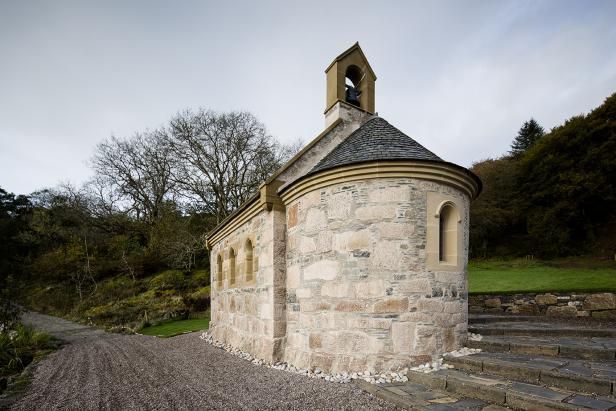"In our high pressure modern lifestyles there is more than ever a need for places where we can step out, take a deep breath and refocus. This small gem of a building seeks to meet this need."
Edinburgh based architects, building surveyors and project managers, GLM make buildings that stand proud and that will stand the test of time. They were commissioned by a busy landowner to design a new-build private chapel on his west coast Scottish Estate.
Neil McAllister, the project architect, worked closely with the landowner to develop the brief, both inspired by the abbey buildings on the nearby Isle of Iona and St Margaret’s Chapel at Edinburgh Castle. The chapel was to be dedicated to the Celtic saint, Comghan, after whom the estate is named.
While this once-in-a-lifetime job was unique there were a lot of similarities with the typical work that GLM carry out doing surveys, repairs and alteration for many traditional churches across the country and designing modern new buildings and extensions for cash-strapped congregations. Here it was clear that quality was paramount without any of the compromises that are often required.
Engaging GLM at an early stage allowed us to advise on the ideal site to meet the unique brief. The chapel sits beside the sea and backs onto woodland facing due east – a convention adhered to strictly by the ancient Celtic church – surrounded by a small garden creating a transition zone before entering through a porch at the north-west corner.
The chapel is a small intimate space which only seats around 15 people on simple oak benches modelled on the ones at St Margaret’s. These can be placed against the walls in a collegiate format or turned to face the altar.
Small intimate space (c) Kevin McCollum Photography
The building consists of simple forms, massive walls and small windows, contrasted with intricate decoration in selected areas. Like the Iona chapels it is Romanesque in style yet also celebrates the early days of Celtic Christianity to which Comghan belonged. This 21st century design is unapologetically eclectic, combining typical Romanesque designs with Celtic key patterns and knotwork. The design uses simple geometric proportions of square, circle and golden rectangle and makes use of the symbolic numbers of three (the Trinity) and seven (creation, perfection, Sabbath rest).
The chapel is traditionally constructed with solid granite walls carrying a self-supporting stone vault and a domed apse. All stone was dressed and carved by hand in a process which would have been familiar to a medieval mason although helped by modern power tools and scaffold. The building is roofed with reclaimed slates from the Easdale quarries - about five miles from the site and topped with a bellcote containing one of the last bells to come out of the famous Whitechapel Bell Foundry.
Hand carved stonework (c) Kevin McCollum Photography
The warm sheen of the handmade terracotta floor complements the stonework and the oak. Intricate carving picks out the entrance and chancel arch. The custom bronze door handles tell the story of St Comghan - an Irish king become monk - in the royal torc ring handles and Iona cross backplates. The tactile nature of the materials – the cold weight of bronze, the roughness of stone and the smooth warmth timber give a sense of calm and permanence.
In an age of throwaway mass production, this building is hand crafted and designed to last and stand as a place of contemplation and worship for generations to come.
Standing as a place of worship for generations to come (c) Kevin McCollum Photography
Find out more about GLM on their website.
The National Churches Trust's Professional Trades Directory connects churches with skilled contractors. We believe in the importance of protecting the traditional craft skills which are essential for the building and conservation of church buildings. By supporting our Professional Trades Directory, you can help us to ensure their future.

